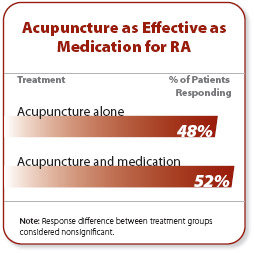Rheumatoid arthritis (RA) is a swelling of the joint linings that causes pain and eventual deformity. Unlike osteoarthritis (actual degeneration of bone joint cartilage), there has not been much attention given to treating RA with acupuncture.
A study published in the May 2008 issue of Clinical Rheumatology has found that acupuncture may indeed be effective in symptom and pain management for patients suffering from RA. Twenty-five patients were given 14 Korean acupuncture sessions over the course of six weeks. All patients were assessed using American College of Rheumatology (ACR) criteria, the Disease Activity Score (DAS28), joint tenderness, swollen joints, morning stiffness and general quality of life (SF-36 questionnaire).

According to the researchers, the acupuncture prescription was individualized based on the five elements principle in Sa-am acupuncture. Sa-am acupuncture, one of the traditional Korean acupuncture styles, uses five shu acupuncture points under the elbows and knees. Tender and swollen joints in RA are thought to result from overheat and excessive dampness. The coupled basic acupuncture points (i.e., HT8 and KI10 to control heat and water balance or SP3 and ST36 for dampness control) were used. Acupuncture needles were given to the unaffected or less affected side. If both sides were equally painful, acupuncture was given on the left-hand side for men and on the right-hand side for women. Two or three predefined acupuncture points were added, depending on the individual patient (LR8, LR2, SP2, LR1, SP1, SI5, ST41, GB41, ST43, SI3, BL66, SI2, LU8, KI7, SP3, and KI3). During needle manipulation, the de qi response was sought, after which the needles were retained for 20 minutes.
At the end of the six weeks, 48 percent of patients showed improvement on the ACR 20 measurement scale. Furthermore, acupuncture also produced statistically significant improvements in the DAS28 scale, pain and global activity measurements, swollen joint count, and the health-related quality-of-life scale (SF-36).
Interestingly, there was no significant difference in ACR 20 measurements between those who also were taking medication compared with those who were not. This appears to indicate that acupuncture alone may achieve almost the same results as medication, but without the potential for harmful interactions or side effects. The researchers noted:
"Forty-eight percent of ACR 20 responders at 6 weeks may not be an impressive result in an uncontrolled study. The participants, however, had relatively moderate or lower disease activities, (i.e., baseline DAS28 4.1±1.0) compared to those included in previous RCTs of RA. Forty-eight percent of the patients were receiving only acupuncture for RA, and the medication was stable in the other 52%. Thus, our finding of 48% regarding ACR 20 responders is worthy of attention."
Acupuncture Today editorial staff members research, investigate and write articles for the publication on an ongoing basis. To contact the Editorial Department or submit an article of your own for consideration, email mailto:
.



